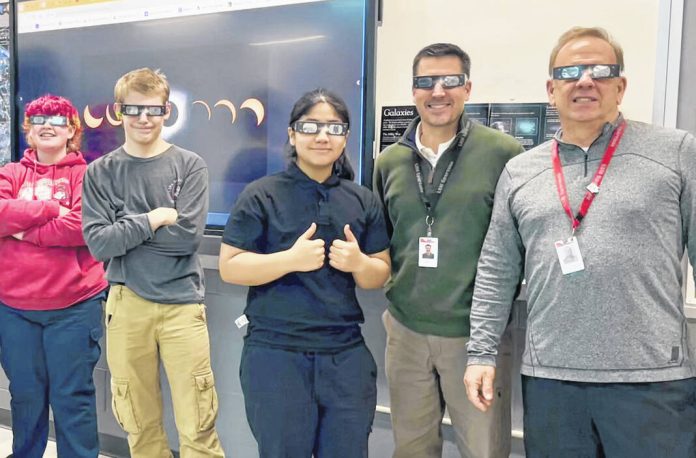LIMA — As career highlights go, the total solar eclipse that will cast surrounding counties into approximately four minutes of total darkness on April 8 is very much in Joel Steinmetz’s wheelhouse.
Steinmetz is the science curriculum team leader at Lima schools, now in his 17th year of teaching with the district. He and fellow science teachers at Lima schools are excited about the eclipse and hope to likewise generate excitement among students.
“We started thinking about the eclipse last year, and this year we got pretty serious about it,” Steinmetz said.
In January the district kicked off eclipse education efforts that culminated last month with presentations to elementary and middle school students from high schoolers and an assortment of other sources.
The eclipse was the subject for this year’s William Fowler Science Series, an event held annually at Ohio State University-Lima and named after the Lima-born astrophysicist who won the Nobel Prize in physics in 1983.
Held in January, this year the series focused entirely on the eclipse, with Wayne Schlingman, the director of OSU’s Arne Slettebak Planetarium, serving as guest speaker. Selected members of astronomy classes at Lima schools were also involved at the lecture.
Steinmetz said two factors associated with the eclipse have worked in teachers’ favor in generating interest among students.
One is the relative uniqueness of the event. According to NASA, the next total solar eclipse expected to be visible from the United States will be in August 2044. The next total solar eclipse visible in Ohio will be in the year 2099, according to the Ohio Emergency Management Agency website.
The other element of teaching about an eclipse is its relative simplicity. There’s not a lot of advanced technology involved, Steinmetz said.
“It’s basically just the moon passing between the Earth and the sun. And that’s part of our normal classroom lessons for fifth-graders in the school district anyway. That’s when they learn about the earth, moon and sun and how they relate to each other.
“This year just provides a unique opportunity for the students,” Steinmetz said. “We talk about how a total eclipse affects pets, wild animals, farm animals, birds. … We tell students what to do leading up to the eclipse — to go outside early and not just at 3 o’clock (when the eclipse nears its march toward totality) — and what to look for.”
In the weeks leading up to the eclipse, students at Lima schools were beginning to show an increasing amount of interest, Steinmetz said.
“Our astronomy students are pretty engaged, and we’re going to try to build that excitement in the younger classes,” he said. “Three high school astronomy classes put together projects that not only were used for classroom instruction but also were placed on the school district’s Facebook page for the community to enjoy.”
Students in the graphics design class at Lima Senior designed special eclipse glasses that were distributed to students.
No classroom instruction will be possible on April 8, the day the eclipse comes to town. Lima schools, like most area school districts, will not hold classes that day in an abundance of caution for safety concerns.
When the eclipse planning by science educators in the Lima district began last year, it was presumed school would remain in session. Now those students will be on their own to soak up the darkness for a brief moment during a special day.
“I’m just hoping the weather cooperates,” Steinmetz said.







